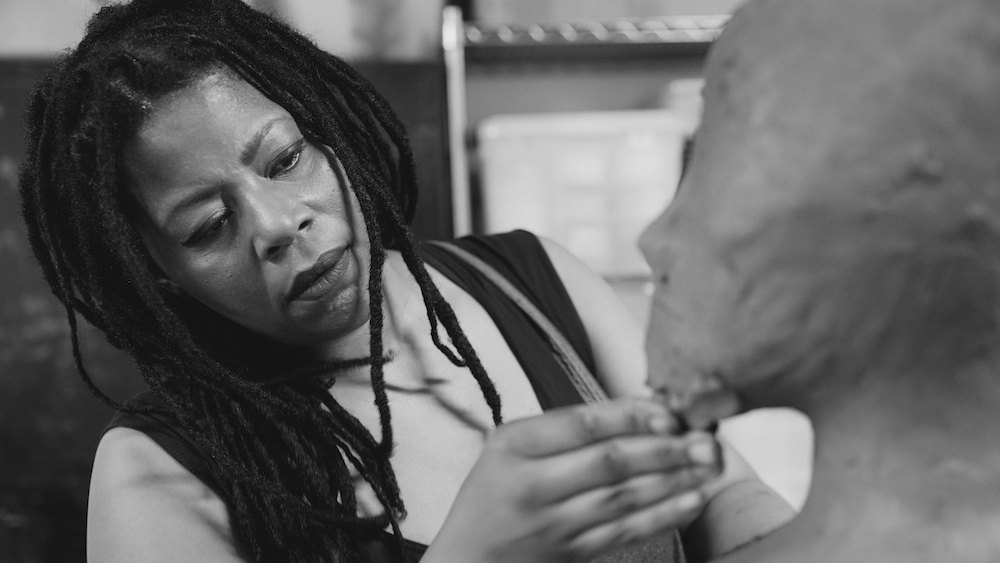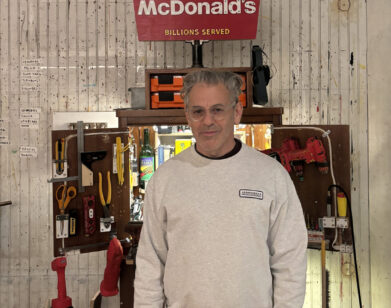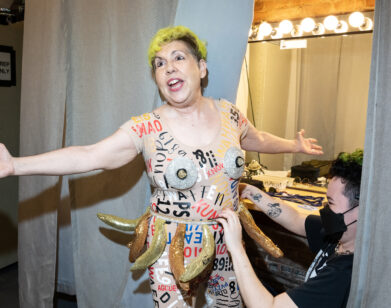Artists at Work: Simone Leigh
SIMONE LEIGH IN BROOKLYN, NEW YORK, JULY 2016. PHOTOS: FRANK SUN.
This summer, during group shows and ahead of fall exhibition openings, we’re visiting New York-based artists in their studios.
“Simone Leigh: The Waiting Room” at the New Museum is installed in an institution, but its implications extend far beyond the museum’s walls. Leigh, a Chicago-born, New York-based artist, uses the exhibition (and her accompanying residency at the museum) to point to the artistry of everyday life—specifically, the community medical and self-care practices that have historically been curated and taught by Black practitioners around the world. Upon exiting the elevators at the New Museum on the fifth floor, one is greeted by a wall lined with jars of medicinal items, as well as an attendant who is there to dialog with guests. The main space functions as a multi-purpose room where a variety of healing activities will take place. Leigh collaborates with experts in health, wellness, and community outreach in order to provide workshops, classes, and discussions on topics ranging from abortion and aging to acupuncture and massage, and also formed a group in which artists meet to discuss Black Lives Matter.
While the exhibition’s spirit is activist and participatory, Leigh has made it clear that it is neither an exercise in mourning nor a call to “save” Blackness. “I’m interested in the transfer of knowledge between women,” she says. “I did not intend to set up a mock NGO pretending to rescue Black people from some abject situation. I’m tiring of having to talk about that post-colonial fantasy. This insistence on focusing on this same savior narrative is so perverse,” she continues. “My project was to expose an arena of expertise, a gold mine of knowledge that we have ignored, or even that we don’t know exists.”
“The Waiting Room” does not position Blackness as tied inherently and inextricably to sorrow and violence; rather, it acknowledges the facts of a racist society while amplifying the self-reliant knowledge of the Black community—a knowledge that has yet to be fully recognized for its requisite skill and empathy. When we visit Leigh in her Brooklyn studio and ask about Black Lives Matter and historical memory, she reminds us of an important story (one that, arguably, encapsulates her characteristic commitment to collective healing).
“I would mention the shooting of nine people in Bible study at Mother Emanuel Church [in 2015], but I feel that people stop there,” she says. “That church has a history of resistance dating back to its founding in 1816. After Nat Turner’s rebellion, all churches in South Carolina were banned, and Mother Emanuel continued to meet in secret for 35 years. The fact that many African American institutions have had to function underground has led to ignorance.”
What’s so important about Leigh’s evocation of this tragedy—in which a white supremacist opened fire during a prayer service, killing nine people who were worshipping in peace—is that it makes clear that Black Lives Matter cannot be positioned as a purely contemporary phenomenon. The shooting at Mother Emanuel revealed a lineage of resistance and fellowship originating in the early 19th century. It is perverse that it takes such a tragedy to bring this rich community to national consciousness, but out of unthinkable violence comes the tool with which to end it—an understanding that anti-racist activism has multiple historical, social, personal, and spiritual valences.
Leigh’s work at the New Museum is not a one-off novelty. The Guggenheim fellow is currently transitioning into creating public commissions for the Studio Museum in Harlem and the Hammer Museum, and takes inspiration from potent sources. A telling essay by Dr. Myisha Priest, titled “Salvation is the Issue,” accompanies the New Museum exhibition in a free broadside and on Leigh’s website. Priest writes, “Death is not the necessary outcome of struggle. There is also freedom. There is also salvation… It is as simple and as profound as restoring a hand’s touch: Brothers, Sisters, Kin. Let us hold their hands in ours, so that all our lives might be saved. Because salvation is the issue.” Salvation is different than rescuing or saving or helping. Salvation taps into the courage and beauty that is already extant in the soul and uses that reserve to revitalize networks of kinship in a society that would destroy them. With racist mythologies surrounding Black women remaining ever prominent, “The Waiting Room” provides a platform to exist not for others, to not be invented by a racist and sexist imagination, but rather to invent themselves, to revel in and enjoy their own knowledge, friendships, and histories. As Leigh explains, “‘The Waiting Room’ focuses on waiting as a socio-political status, a psychological preoccupation of Black women.” This exhibition is a site where Black women can engage in the discourses and histories that have shaped their lives, take ownership of their power as individuals and as a group, instead of being told to be patient by a racist, masculinist society. Leigh has contributed to what she calls “an arsenal to combat obedience, a major cause of death among Black women” by cultivating a space for the consummation of previously denied desires—the desire to be seen, to be valued, to be safe, to exist cooperatively and not in fear, that is, to finally throw open the doors of the waiting room of culture.
“SIMONE LEIGH: THE WAITING ROOM” WILL BE ON VIEW AT THE NEW MUSEUM THROUGH SEPTEMBER 18, 2016. FOR MORE ON LEIGH, VISIT HER WEBSITE.







